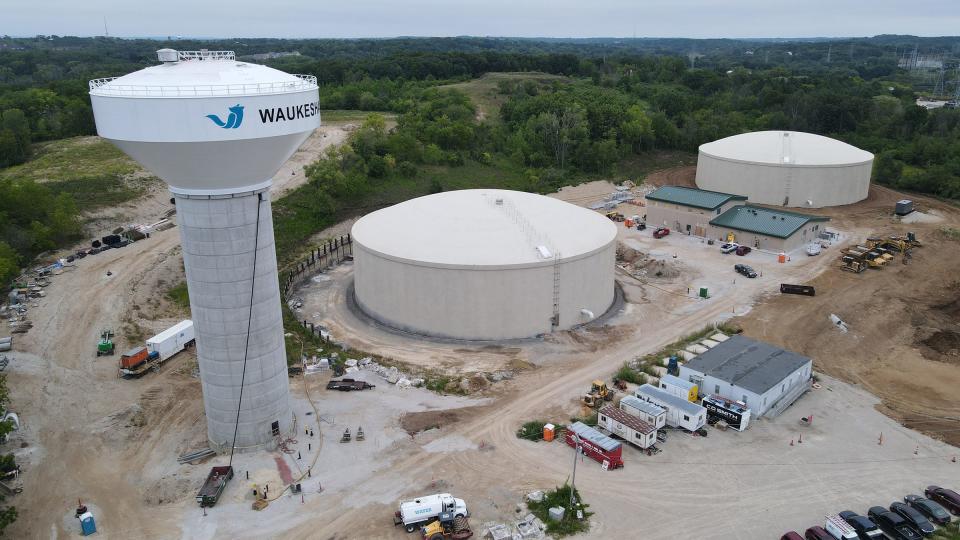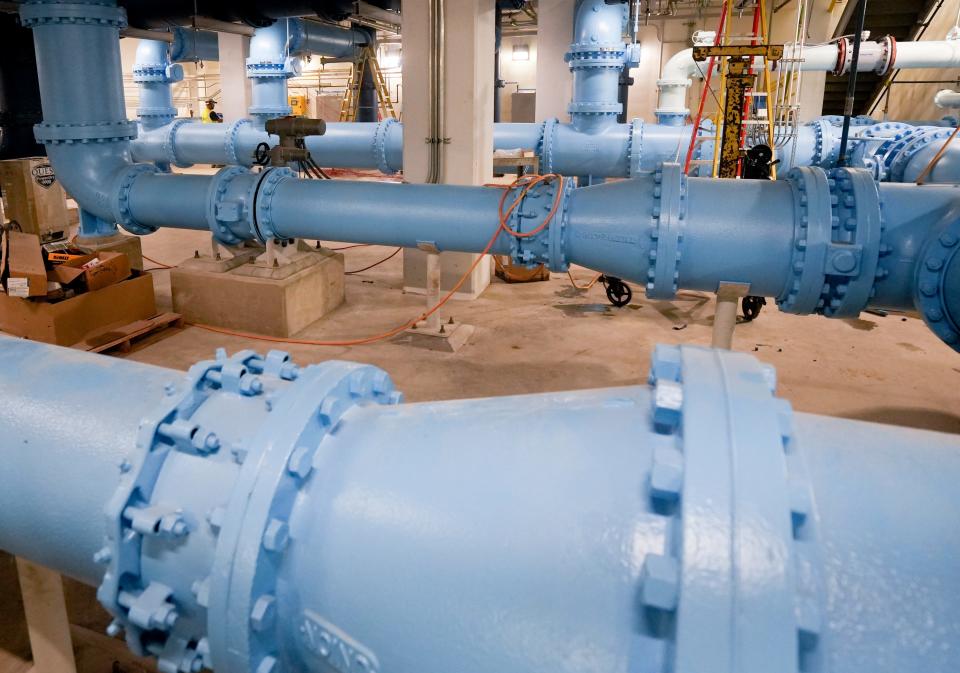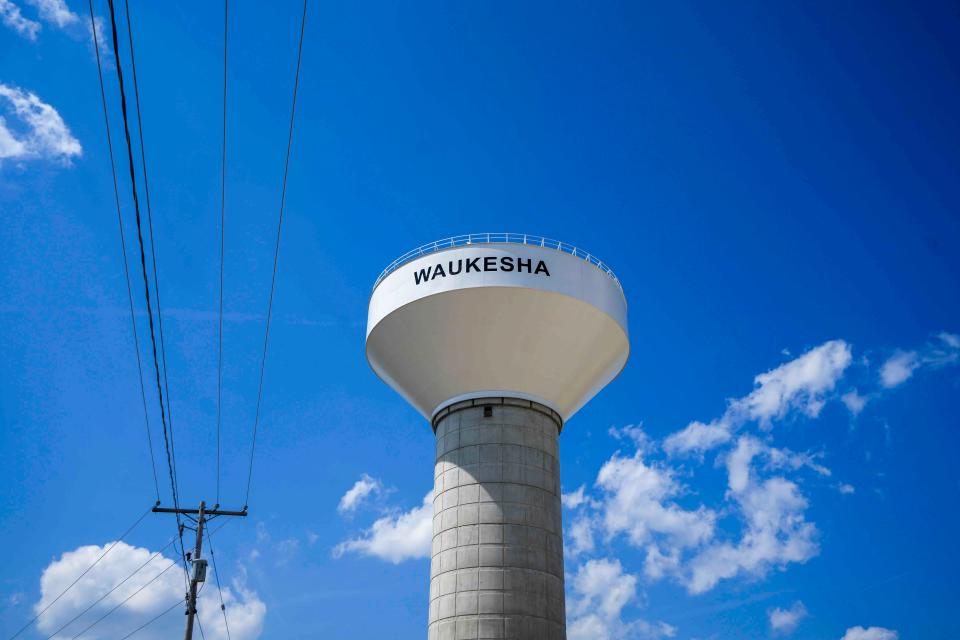Waukesha residents will soon drink Lake Michigan water. What to know about the controversial diversion project.
WAUKESHA – An overwhelming smell of fresh paint wafts out of the city of Waukesha’s new booster pumping station. The two-story building is filled with water pipes painted two different colors, designating the direction the water is heading.
Light blue: Water coming in from Lake Michigan via Milwaukee.
Dark blue: Water going to Waukesha.
When Waukesha residents turn on their faucets in mid-September, they will see Lake Michigan water — a curtain call for a decades-long effort to secure the city a new water source.
The city of Waukesha was the first community in the country located entirely outside the Great Lakes basin to get a water diversion approved under the Great Lakes Compact. The landmark agreement that says water can’t leave the basin.

The city’s request is the biggest test of the compact to date.
“This is a big historical moment for the Great Lakes, and especially the Great Lakes Compact,” said Peter Annin, author of "The Great Lakes Water Wars."
The diversion, which was approved seven years ago, faces a lot of scrutiny to this day.
And it serves as a reminder that water isn’t a guarantee — even minutes away from the world’s largest surface freshwater system.
Here’s what’s going on in Waukesha and how the city got there.

Waukesha’s water supply contaminated with radium
Waukesha’s old water supply came from a deep aquifer that extends from southeastern Wisconsin to northwestern Illinois.
A layer of shale that sits between the surface and the water causes the aquifer to replenish slowly. And over time it has depleted, which has in turn increased the concentration of naturally occurring radium — a carcinogen.
The city of Waukesha was under a court order to find a new water supply by 2018, which was pushed back to September 2023.
Great Lakes Compact bans water diversions with limited exceptions
In 2008, the eight Great Lakes states signed the Great Lakes Compact, outlining how the states will manage and protect the Great Lakes-St. Lawrence River basin. Ontario and Quebec, the two Canadian provinces that border the lakes, have a parallel agreement.
There are very few exceptions in who can ask for Great Lakes’ water. Communities that lie on top of the basin line can apply for a diversion and need approval only from the state governor.
Communities that sit just outside the basin line but are in a county that straddles the watershed line can also ask. But this requires the approval from all eight Great Lakes states as well as Ontario and Quebec.
To date, the Waukesha diversion is the only one like this that’s been approved.
Waukesha will pay up to $4.8 million per year for lake water
The city first submitted its application to the Wisconsin Department of Natural Resources in 2010, which was followed by six years of review by Wisconsin and other natural resource agencies around the region.
The governors approved the diversion in 2016, which included the use of up to an average 8.2 million gallons of lake water a day. Construction of the pipelines and pumping stations began in 2020.
Waukesha is purchasing Lake Michigan's water from the City of Milwaukee. The annual cost will range from $3.2 million to $4.8 million depending on how much water Waukesha uses, said Dan Duchniak, the general manager at Waukesha Water Utility.

It also made a $2.5 million one-time payment to Milwaukee as a part of the deal, which will help fund lead service replacements, he said.
And Lake Michigan’s water will come at a cost to Waukesha residents. Water bills will rise to $154 a month, roughly 2.5 times higher than they are now.
The cost will be about $600 more per year for residents, Duchniak said, but this will be offset by the fact that households will no longer need to have water softeners.
“You need to have clean, safe drinking water, and the residents of Waukesha are going to have that now,” Duchniak said.
Waukesha will return all of the water to Lake Michigan
A requirement of the compact is that the water is only borrowed. Diverted water must be returned to the lakes minus consumptive use.
But Duchniak said that Waukesha will return 100%, so there will be no net loss to the lakes.
It will treat extra groundwater to cover the difference, he said, setting a high bar for diversion requests that follow.
The city will return treated water back via the Root River, which enters Lake Michigan at the city of Racine.

The process showed the Great Lakes Compact worked
At the time the compact was written, it was well-known that Waukesha was gearing up to ask for Lake Michigan water.
Communities in counties that straddle the divide must first apply through the state before it is kicked up to regional review. There were years of back and forth between the Wisconsin DNR and the city of Waukesha before it made it to the governors in 2016.
The vigilance of environmental groups applied pressure to the process, Annin said. The final application that made it to the governors’ desks was around 3,000 pages and received 11,000 comments from around the region.
The city was greedy in the initial rounds of applications, said Marc Smith, policy director at the National Wildlife Federation’s Great Lakes office. It asked for an exorbitant amount of water and wanted to pump water to towns nearby that didn’t need it, he said.
But the Great Lakes’ governors whittled it down, reducing the amount of water the city was allotted and taking out the nearby towns.
The compact process didn’t make it easy, and the Waukesha diversion shows that it works, Smith said.
Some environmental groups still have doubts
Even after the Great Lakes’ governors approved the request, the conversation didn’t end there. A binational group of mayors of Great Lakes cities spoke out against the approval. And sour feelings never completely subsided for environmental groups around the region.
“There will always be people who love or hate a decision that’s made under the Great Lakes Compact, and Waukesha exemplified that,” Annin said.
Some say diversions should be a last resort and that the city should have treated the radium, as many other places do.
Duchniak said that wouldn’t have been a long-term solution.
Another concern is the return flow to the Root River, said Jennifer Bolger Beceda, executive director at Milwaukee Riverkeeper.
The river’s flow will increase greatly, Bolger Beceda said, becoming a wastewater-dominated stream. She said it's uncertain how that will affect the ecology of the river.
Higher water bills may drive inequity in the city, she said. She also worries that many residents won't want to switch over from their wells and will resort to using plastic water bottles instead.

Waukesha isn’t the only community reaching for Great Lakes water
There have been four other diversion requests approved in Wisconsin, all in the southeastern part of the state. The difference is those requests have all been from communities that lie on the basin line and only needed approval from the state governor.
Dwindling groundwater supplies are also a problem in northeastern Illinois. Except there is one big difference: The compact rules don’t apply.
Chicago started diverting water from Lake Michigan in the late 1800s after it reversed the flow of its river. For decades, Illinois and the other seven states fought over how much water should flow through the backwards river. In 1967, the Supreme Court set the limit at 2.1 billion gallons per day on average.
Illinois can do whatever it wants with Lake Michigan’s diverted water as long as it stays below that limit.
So far, more than 200 communities have tapped into the diversion. And earlier this year the city struck a billion dollar deal to add Joliet and five of its suburbs by 2030.
It can even turn the Chicago River back around, changing the direction back into Lake Michigan during times of high flooding.
The compact protects the lakes from out-of-state diversions
As climate change brings uncertainty, groundwater levels drop and new contaminants emerge, the region should think about ways to conserve water, said Molly Flanagan, vice president for policy at the Alliance for the Great Lakes.
“It’s really important we never take the Great Lakes for granted,” Flanagan said.
“The better we are at stewarding this resource, the more we’ll be able to depend on it for drinking water and economic growth,” she said.
The Waukesha diversion shows that asking for Great Lakes’ water is a slow and expensive process, and should only be used as a last resort, she said.
And although many people often worry about Great Lakes’ water being diverted to other states, Annin said the lakes have never been better protected.
We’re surrounded by negative environmental news all the time, Annin said, but the compact is a victory.
More: Is pumping Mississippi River water west a drought solution or a pipe dream?
Caitlin Looby is a Report for America corps member who writes about the environment and the Great Lakes. Reach her at clooby@gannett.com or follow her on Twitter @caitlooby.
Please consider supporting journalism that informs our democracy with a tax-deductible gift to this reporting effort at jsonline.com/RFA or by check made out to The GroundTruth Project with subject line Report for America Milwaukee Journal Sentinel Campaign. Address: The GroundTruth Project, Lockbox Services, 9450 SW Gemini Dr, PMB 46837, Beaverton, Oregon 97008-7105.
This article originally appeared on Milwaukee Journal Sentinel: Waukesha to begin diverting water from Lake Michigan in September

